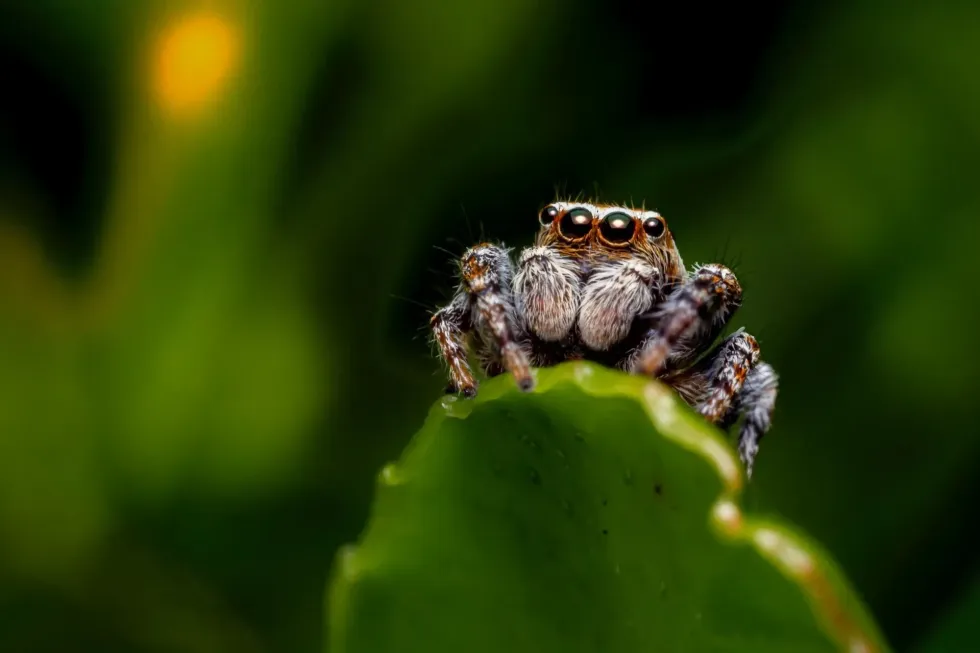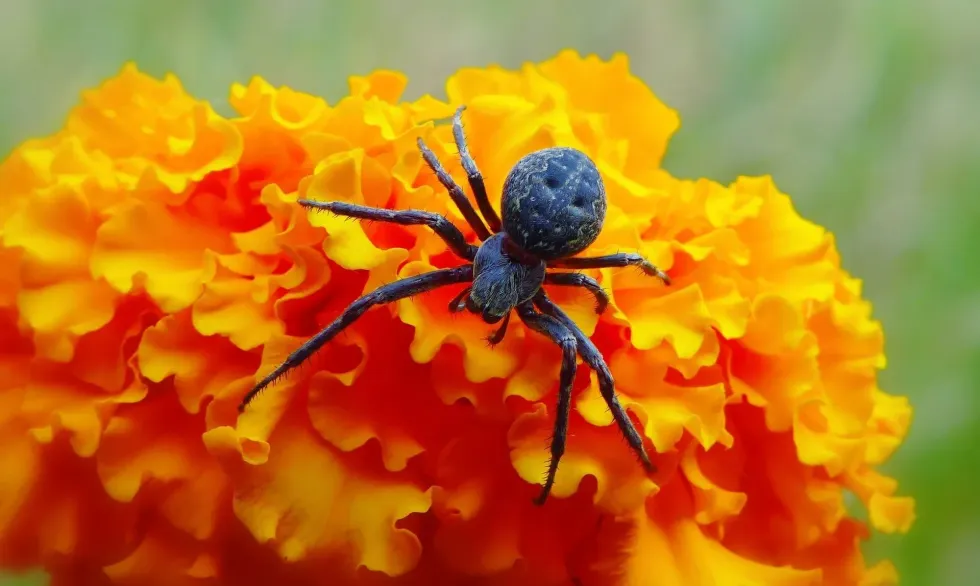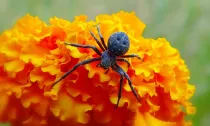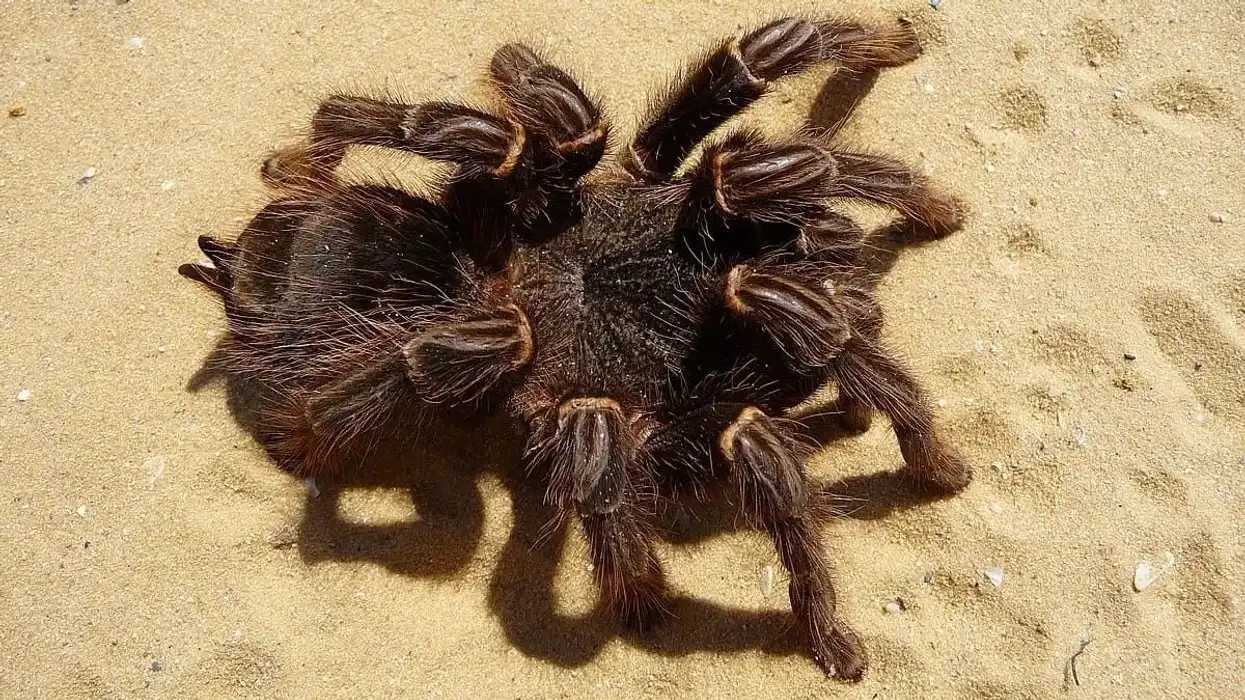67 Incredible White-Tailed Spider Facts For Curious Kids

To be honest, one of the fascinating aspects of our world has to be the presence of insects.
In our everyday life, we may not notice species like the white-tailed spiders, but insects are there. If you are in the countries of Australia or New Zealand, you might have crossed white-tailed spiders, but it will have appeared like any other black house spider.
Apart from the numerous eyes that spiders have, these small creatures amaze us with the ability to make neat webs almost instantaneously. However, the white-tail spider is known for being a ruckus, as it tends to hunt by envenoming its prey.
But, this has also led to instances where the spider has ended up biting a human.
Even though its venom won't be able to kill you, it's always good to know about a spider bite. And, it would also let you learn that the white-tailed spiders may not be as villainous as you thought.
Therefore, do keep reading if you're interested in learning about the world of white-tails.
Characteristics Of White-Tailed Spiders
Have you ever tried to imagine what the characteristics of a spider might be? If not, then let's check out those of the white-tailed spiders.
- White-tailed spiders don't really have a white-tail but got the name from the white spots present at the end of their abdomen.
- Along with the abdomen, the white-tailed spiders may also have a distinct white spot above their spinnerets.
- Apart from the white spots, the body is predominantly dark reddish-gray or cigar brown and has a cylindrical shape.
- The slender legs of these spiders are often glossy or shiny.
- Rather than being a single species, white-tailed spiders are two common species, Lampona cylindrata, and Lampona murina.
- The L. cylindrata is said to have the tendency to grow slightly larger than the L. murina.
- Predominant in southern and eastern Australia, both white-tailed spider species have been introduced to New Zealand.
- The typical body size of a white-tailed spider is around 0.7 in (18 mm) with a leg span of 1.1 in (28 mm).
- Even though we are talking about white-tailed spiders from two species, there are other spiders classified as white-tail because of the presence of white spots on the body.
- The L. cylindrata spiders are known for laying pink eggs that are housed in flattened silk capsules, and females guard the egg clusters until hatching. Around 90 eggs are laid in each cycle.
- After the eggs hatch, the hatchlings are on their own and have to search, looking for their first food instantly.
- One of the ways to differentiate between the sexes is to look for the narrow plate or scute present on the abdomens of male spiders.
- These white-tailed spiders are one of the species of spiders known for eating other spiders. Common prey includes curtain-web spiders, daddy-long-legs spiders, redback spiders, and black house spiders.
- White-tailed spiders have special scopulate hairs on their legs to walk easily on sloped or smooth surfaces.
- These spiders are most active during the night, as it's hunting time.
- Even though the white-tailed spider is, in fact, a spider, it doesn't spin webs but rather envenoms its prey for consumption.
- As these spiders don't spin webs, the species is categorized as running or hunting spiders.
- Sometimes, the favourite prey of white-tails, daddy long legs, may cover the spider up in its silk to prevent the white-tail from invading its territory.
- For some reason, there is quite a widespread myth that white-tails travel in pairs, but like most other spiders, the white-tailed spider might also prefer to travel alone as a solitary species.
- White-tailed spiders are classified into the Phylum Arthropoda, Subphylum Chelicerata, Class Arachnida, Order Araneae, Infraorder Araneomorphae, and Family Lamponidae.
Habitat Of White-Tailed Spiders
When it comes to spiders, perhaps one of the most dreadful thoughts would be to find them in undesirable spaces. That might be one of the reasons for being to be actually scared of the white-tailed spider.
- The usual habitat for these spiders is under rocks, leaf litter, or fallen tree barks.
- The different habitats described for this species include urban, dry forest, wet forest, woodland, mallee, and grassland.
- White-tailed spiders are quite active during the summer months.
- This spider is known for being quite a nuisance as it often hides in clothing and bedding, leading to most of the bits that befall humans.
- The Lampona cylindrata spiders are found mainly in southeast Queensland, New South Wales, Victoria, Southern Australia, Tasmania, as well as Western Australia.
- While the Lampona murina is found in the eastern part of Australia, from northeast Queensland to Victoria.
- As we have said already, even though New Zealand isn't the native for these spiders, both species have been introduced to the country. It has been well over a hundred years that the Lampona murina has been living in the northern half of New Zealand. But, the Lampona cylindrata has only become prolific in the southern part as recently as the '80s.
- As you can understand, the white-tail can adjust to both bush and urban environments.
- White-tails usually round back to your home because it's in search of black house spiders. So, it won't deliberately bite humans.
- When outside, white-tailed spiders don't enjoy a damp environment.

How to survive a bite from the White-Tailed Spider?
Most of the people who know about the white-tail spider are afraid of getting bitten. Hence, here are some of the facts we gathered about white-tailed spider bites.
- The main purpose of the white-tailed spider bite is to drive venom into the body of its prey.
- Even though spider bite from white-tailed spiders has been told to be a common phenomenon, the spider doesn't have enough power to cause human death.
- The typical concern of people regarding getting a spider bite from this species is developing ulcers on the bit site.
- In most cases, bites on the human skin result in the formation of a red mark, mild swelling, irritation, and some rashes. Immediate care for any spider bite gives a solution, and it won't cause any harm to you.
- Unlike some other species, the venom of the white-tailed spider isn't that strong. When it comes to the deadliest spider in the world, the place is still occupied by the male Sydney funnel-web spider, the Atrax robustus.
- The white-tailed spider was thought to be a dangerous species, as some people claimed that a spider bite could soon lead to necrotic lesions. But, further studies revealed that white-tails didn't have venom strong enough to cause necrotic lesions.
- The most common reason for the growth and development of ulcers was due to the bite site getting infected when left untreated.
- There is no need to really be scared and worry about getting white-tailed spider bites. Just locate the spider bite site and clean it gently with water. Then, the only thing you need to do is apply an ice pack to the location, and the red mark or swelling will soon go away. If you see that the skin is starting to blister, contact the nearest emergency care.
- One of the best things about Australia is that they are quite aware of the occurrence of white-tailed spider bites. Hence, on visiting a hospital or even on the healthcare website, you can find enough information about dealing with white-tailed spider bites.
- Following on the point of necrotic lesions, most spiders that have a strong venom have the tendency to give you necrotizing arachnidism, which is a necrotic sore from a spider bite. However, extensive studies were done by The Medical Journal of Australia on white-tailed spider bites, and none among the 130 cases developed necrosis from their spider bite.
- Many doctors believe that in some cases, a spider bite may progress into necrotizing arachnidism, not because of the spider itself, but because of underlying issues like diabetes or any other chronic disease.
- Similarly, people with a white-tailed spider bite that had developed necrosis or ulcers were thought to have been misdiagnosed. Many believe it can be things as simple as a secondary bacterial infection or fungal infection.
- Currently, there exists no such treatment or antivenom that has been specifically made for a white-tailed spider bite.
- In the case of ulcers, doctors, in many cases, have used hyperbaric oxygen therapy to heal the white-tailed spider bite.
- If you have got bitten by any spider, one thing that should be avoided is to scratch the area. Excessive scratching may lead to breakage of the skin, which creates a pathway for bacterias to enter your body.
- Even though it's far less common, white-tailed spiders can also end up biting your pets. It can often be hard to see the bite location due to the fur on a cat or a dog. But, if you suspect a spider bite, do consult a vet immediately to get the treatment started. Symptoms in pets may include irritation, drooling, and vomiting.
- One of the common symptoms of a white-tailed spider bite is the emergence of blisters. Yes, it can be quite tempting to poke a blister to get some relief. However, that won't be the right thing to do. Instead, if you see a blister coming, the best possible thing to do would be to seek medical attention.
Facts About White-Tailed Spiders
Here are some other miscellaneous facts about the white-tailed spider that you might want to know.
- The long legs of the white-tailed spider come to its advantage while feeding on the prey as it helps in maintaining a better grip.
- The white spot present on the abdomen doesn't necessarily mean that it would be clearly white. In most cases, the white-tail spider has grey dots.
- One of the most interesting things about the white-tailed spider has to be the way the myth about the spider bite was formed. As we have already been told, The Medical Journal of Australia has established that the white-tailed spider bite is quite minor to humans. But, it's said that in the '80s, there was an Australian man who got necrotic lesions from a spider bite, and somehow it was attributed to the white-tail. However, scientists also believe that the fear of the white-tailed spider bite is much more ingrained in culture.
- There are more than 10,000 spider species living in Australia, but hardly two out of them would be harmful enough to hurt a human. Instead, other animals like snakes and bees would have a better chance of killing humans.
- As recently as 2017, a news source in Australia claimed that a man had lost his legs due to necrotic lesions caused by white-tailed spiders. But, soon, it was debunked by doctors, and they noted that it could have happened because the bite got infected, rather than the bite itself.
- One of the problematic things with the white-tailed spider is that the species tend to get into houses during summer months. This is mostly due to the search for other spiders. The easiest way to get rid of white tail spiders is the trap and release method. For this, you need to identify the places where the spider might be lurking and trap it. Try to search for dark corners or in-between clothes where the species likes to hide. It's the most natural way of getting rid of spiders.
- On top of that, if you live in Australia and have found other spiders living in your home, it's better to clear the insects to protect the house from white-tailed spiders.
- If you have never cleared out spiders before, it might be a good idea to call a professional pest control who is adept at dealing with venomous species.
- There might be times when you still end up finding a white tail spider in your house, especially while going through the bedding or clothes. Try to be as calm as possible and take the initiative to move the spider outside. Don't try to hit the spider with anything, as this may trigger its protective nature, and you may end up bitten.
- In the case of a heavy infestation of any kind of spider, the best thing you can do is to spray a commercial-grade bug spray or insecticide around your house. However, make sure to ventilate the space properly after doing spraying to decrease the chance of inhaling the toxins.
- Don't like the idea of inhaling toxic bug sprays? A quick tip would be to try peppermint oil. You can take some water in a spray bottle, mix some peppermint essential oil into it and spray it around the house. Along with making the white-tailed spiders leave your house, it would also clean out other pests like ants and flies.
- Another natural way can be to use vinegar and water spray to ward off spiders. However, try to use the kinds of vinegar that aren't too sweet or sticky, as this can bring in ants.
- Most white-tailed spider bites on humans take place indoors in the summer months and at night. So, if you live in East or South Australia and if your area is known for having common white-tail spider infestations, it's always better to be careful.
- The irritation and pain from a white-tailed spider bite can last for anywhere between 5-12 days.
- Let's talk about the naming history of the two species. Ludwig Carl Christian Koch was the one behind describing both species of white-tailed spiders. In 1866, he first described the Lampona cylindrata, and later in 1873, he described the Lampona murina.
- Koch took the genus name from the Latin word 'lampo', which stands for 'to shine'. This is because of the glossy or shiny legs of these spider species.
- The name 'cylindrata' stands for the cylindrical body of the species, while the name 'murinus' stands to describe the color mouse grey in Latin.
- It's often said that these spiders may have further white or grey spots on the body. But, with adulthood, these spiders go through molting, in turn losing the other spots while the one on the abdomen remains.
- There is a belief that all venomous spiders are aggressive in nature, but that isn't true. And, similarly, even the white-tailed spider is seldom aggressive.
- Even though white-tailed spiders are thought to be a nuisance, the species can actually be a boon for your home. It's known for feasting on other poisonous or venomous spiders like the redback that can also enter your home. The redback spider is definitely much more venomous than the white-tailed, and when bitten by them, anti-venom is required. The white-tailed spider is known to eat the daddy-long-legs species, which is also considered more venomous.
We Want Your Photos!
More for You
Doctorate specializing in Veterinary Medicine

Oluniyi AkandeDoctorate specializing in Veterinary Medicine
With an accomplished background as a Veterinarian, SEO content writer, and public speaker, Oluniyi brings a wealth of skills and experience to his work. Holding a Doctor of Veterinary Medicine degree from the University of Ibadan, he provides exceptional consulting services to pet owners, animal farms, and agricultural establishments. Oluniyi's impressive writing career spans over five years, during which he has produced over 5000 high-quality short- and long-form pieces of content. His versatility shines through as he tackles a diverse array of topics, including pets, real estate, sports, games, technology, landscaping, healthcare, cosmetics, personal loans, debt management, construction, and agriculture.
Disclaimer
1) Kidadl is independent and to make our service free to you the reader we are supported by advertising. We hope you love our recommendations for products and services! What we suggest is selected independently by the Kidadl team. If you purchase using the Buy Now button we may earn a small commission. This does not influence our choices. Prices are correct and items are available at the time the article was published but we cannot guarantee that on the time of reading. Please note that Kidadl is a participant in the Amazon Services LLC Associates Program, an affiliate advertising program designed to provide a means for sites to earn advertising fees by advertising and linking to Amazon. We also link to other websites, but are not responsible for their content.
2) At Kidadl, we strive to recommend the very best activities and events. We will always aim to give you accurate information at the date of publication - however, information does change, so it’s important you do your own research, double-check and make the decision that is right for your family. We recognise that not all activities and ideas are appropriate for all children and families or in all circumstances. Our recommended activities are based on age but these are a guide. We recommend that these ideas are used as inspiration, that ideas are undertaken with appropriate adult supervision, and that each adult uses their own discretion and knowledge of their children to consider the safety and suitability. Kidadl cannot accept liability for the execution of these ideas, and parental supervision is advised at all times, as safety is paramount. Anyone using the information provided by Kidadl does so at their own risk and we can not accept liability if things go wrong.
3) Because we are an educational resource, we have quotes and facts about a range of historical and modern figures. We do not endorse the actions of or rhetoric of all the people included in these collections, but we think they are important for growing minds to learn about under the guidance of parents or guardians.







